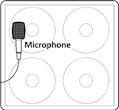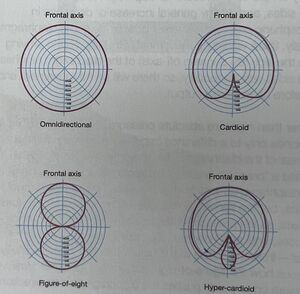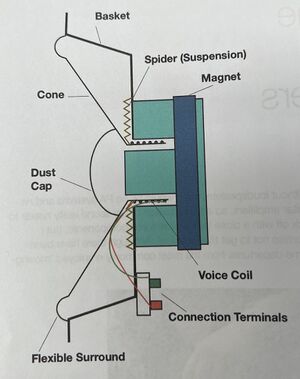This is the wiki for products made by Fractal Audio Systems, maintained by members of the community.
November 2025: the entire wiki has been updated with information about the new AM4 amp modeler.
Speakers and microphones

About microphones
Impulse responses are captured using microphones and mic preamps.
"Using a "neutral" IR with a simulated mic does not sound the same as an IR using that mic. It simply can't. Neutral mics like the Earthworks TC series are nearly omnidirectional. They operate by using a very small aperture as compared to traditional mics that have effective apertures orders of magnitude bigger." [1]
"The mic I've been most impressed with for recording guitar lately is the Beyer M160. I don't like SM57's alone for amps. They're too spikey and compressed but mixed with an M160 or R121 they add some nice sizzle." [2]
"The M160 is an awesome guitar cab mic. All the IRs we got with the M160 came out really nice." [3]
"My typical workflow is to choose an R121 or M160 first as these have the best low end. Then I choose an IR from one of the other mic types to get the desired brilliance. This is usually an SM57 or 4047. I just don't like 906s or 414s but that's me. I leave the panning at default but that's just my preference." [4]
"If you get a chance try a Shure KSM313, an AEA R84 and a Beyer M160. The KSM313 is now my preferred mic for guitar cabs. I like it better than the R121. I find the KSM313 a little more balanced. The R121 has a lot of bass and proximity effect and the high end can be a little dull." [5]
"My favorite mic for guitar cabs is the KSM313." [6]
"Certain mics like the royer 121 have 2 sides (front, back). Each has a different sound. Back side of the R121 is a bit darker. The difference between the front in the back is only apparent at closer mic distances. Get out past 3 feet and the sound the same on either side."
"The M160 is a good mic but there are better ribbon mics. My personal favorite is the KSM313. It's more balanced and has better high frequency response. I haven't tried the KSM353 yet but I imagine it's even better. [7]
"IMHO nothing beats a KSM313 for "neutral" close mic'd IRs." [8]
Dialing in Your Tone by Red Wirez provides useful info about mics and mic positioning.
Wikipedia:
Additional information about microphones:
- http://www.soundandrecording.de/tutorials/mikrofonvergleich-vor-dem-e-gitarrenverstaerker
- Wikipedia
- http://soundschematic.com/dynamic-ribbon-condensor
- http://www.barryrudolph.com/stellar/guitar.html
- http://www.gearslutz.com/board/so-much-gear-so-little-time/201972-mic-standards.html
- U67
- SM57
- SM58
- MD421
- U87
- D112
- Beyer M160, Beyer M160
- Sweetwater: Guitar Cabinet Mic Shootout – with Sound Samples
- The Importance of Mic Placement for Guitar Amps – with Sound Samples
- What's the difference between Shure SM57 and SM7b
From "The SOS Guide to Live Sound" by Paul White:
About guitar speakers

Impulse responses reproduce the sound of a speaker cabinet. Here's some background information on guitar speakers.
- Speakers: the final frontier
- Legendary Tones: G12M versus G12H
- Sound On Sound: choosing guitar-amp speakers
- Sound on Sound: understanding and recording guitar speakers
- Eminence tone guide
- Fenderguru: selecting speakers
- Celestion history
- Pre-Rola greenbacks explained, part 1
- Pre-Rola greenbacks explained, part 2
- Premier Guitar: how a speaker cabinet influences your tone
- Sound clips of Celestion speakers on SoundCloud
Jensen speakers:
- P12R: 12” 15W
- P12Q: 12” 20W
- P12N: 12” 30W
- P10R: 12” 15W
"Break-in is definitely real with guitar speakers. The surround is stiff when new due to the doping. I don’t think monitors and hifi speakers exhibit any significant break-in." [9]
"We witnessed speaker break-in first-hand when shooting IRs. We bought a brand-new 5150 III cabinet. Went to shoot some IRs and they sounded terrible. So I put the synth block on and ran the speaker for several hours while we were doing other stuff. Came back and shot some IRs and they were much better sounding." [10]
How a speaker works: electricity runs through the voice coil (wire), creating an electomagnetic polarity that shifts depending on the input signal. This makes the coil move closer or away fom the magnet.
Ohm = AC Resistance (not: AC current) = impedance. Adding speakers in series increases resistance, adding speakers in parallel decreases resistance. Examples:
- 2 identical speakers wired in parallel: combined impedance is half that of the individual speaker (2 x 8 ohm = 4 ohm)
- 2 identical speakers wired in series: combined impedance is doubled (2 x 8 ohm = 16 ohm)
From "The SOS Guide to Live Sound" by Paul White:

